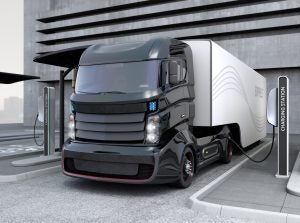 Electric heavy-duty vehicles have come a long way in a pretty short time. Back in 2018, we were excited about prototype vehicles and trucks with 60-mile range. Today there are scores of truck models available at ever increasing ranges, clear market segments where these vehicles can thrive today, and ever-growing fleet interest in deploying these vehicles.
Electric heavy-duty vehicles have come a long way in a pretty short time. Back in 2018, we were excited about prototype vehicles and trucks with 60-mile range. Today there are scores of truck models available at ever increasing ranges, clear market segments where these vehicles can thrive today, and ever-growing fleet interest in deploying these vehicles.
In five years, we have gone from electric heavy-duty vehicles as conceptual to being commercialized and a major component of the future of trucking.
Along the way, it has become clear that the limiting factor for fleet adoption of electric heavy-duty vehicles is not about the technical capabilities of these vehicles. Instead, it’s the lack of support systems for fleet use of these vehicles.
4 ways manufacturers can support fleets on their road to electrification Click To TweetFor example, the operational ease of charging electric trucks is of paramount importance for successful deployments – but not all chargers are the same. This is one place that manufacturers can help, by undertaking extensive charger compatibility testing for each electric vehicle model.
The idea that truck manufacturers have a central role in determining the successful deployment of electric trucks is something the Electric Fleet Readiness Group has been recently focused on. Comprised of fleets on the leading edge of electrification, Dependable Highway Express, Manhattan Beer Distributors, NFI, Pitt Ohio, and Anheuser-Busch, in collaboration with CALSTART, NACFE, RMI and EDF, have identified four ways that manufacturers need to support fleets in their deployment of EVs.
- Objective, comparable performance data: Successful deployments start with fleets having access to objective, comparable performance data. Only then can fleets make well-informed purchase decisions with the confidence that they are set-up to succeed. Fleets, of course, have collected data on the performance of their diesel vehicles. Given the early stage of the electric truck market, fleets do not have previous performance data from which they can readily draw. Examples of the type of data fleets need include range estimates that are calculated in a consistent, transparent manner so fleets can assess the best fit between vehicle models from different manufacturers. Another example is getting a detailed breakdown of anticipated impacts in maintenance costs. Much of the information provided to fleets is aggregated estimates — so it could hide some meaningful impacts and is too general for high-quality cost-of-ownership assessments.
- Charging system readiness and optimization: To ensure that fleets are set-up for successful charging of their vehicles, manufacturers should undertake extensive charger compatibility testing — including leading third-party electric vehicle service equipment. Interoperability is of critical importance for fleets, which cannot afford to have to have different chargers and connectors, or even vehicle charge port locations for different makes of trucks. Fleets also need useful information to optimize their charging systems, including charging rates and conditioning strategies.
- Flexibility in upfitting vehicles: Heavy-duty trucks are highly customized to the needs of the purchasing fleet. Manufacturers need to be building in the capacity for fleets to have flexibility in upfitting their new electric vehicles. This could include offering multiple battery size options or in the specific level of charger-vehicle optimization. Many fleets choose to operate vehicles from multiple OEMs and therefore desire to have a single charging solution that works with all their vehicles. Other fleets may decide to focus on a single manufacturer or model that best meets its specific needs and want a charging solution that is optimized for their vehicles. Fleets should have the ability to decide on the level of compatibility that best meets their needs.
- Provide expanded support: Finally, there is a lot of soft infrastructure needed for successful EV deployments too. Manufacturers and their dealers need to be able to provide new and expanded levels of support for fleets advancing along their electrification journey. For example, while fleets have always seen a broad range in energy consumption between drivers, the discrepancies between drivers appears to be growing with the introduction of electric vehicles. OEMs and their dealer partners could provide training for drivers moving into electric trucks to enable them to maximize vehicle efficiency and range.
Transitioning to electric heavy-duty vehicles is important to many stakeholders. Fleets will always be at the center of this transition. However, the ultimate success of their deployments depends on many issues beyond their control. Manufacturers are one of the many stakeholders that have a critical role in ensuring a swift and successful transition. To set fleets up for success, manufacturers need to make sure the level of support they are providing fleets reflects the opportunities and challenges of running electric trucks.